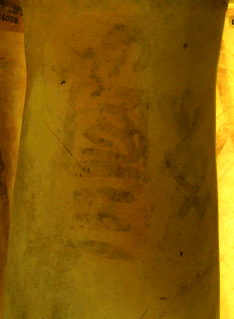 W
WThe title "Pharaoh" is used for those rulers of Ancient Egypt who ruled after the unification of Upper and Lower Egypt by Narmer during the Early Dynastic Period, approximately 3100 BC. However, the specific title "Pharaoh" was not used to address the kings of Egypt by their contemporaries until the rule of Merneptah in the 19th Dynasty, c. 1200 BC. Along with the title Pharaoh for later rulers, there was an Ancient Egyptian royal titulary used by Egyptian kings which remained relatively constant during the course of Ancient Egyptian history, initially featuring a Horus name, a Sedge and Bee (nswt-bjtj) name and a Two Ladies (nbtj) name, with the additional Golden Horus, nomen and prenomen titles being added successively during later dynasties.
 W
WCrocodile is the provisional name of a predynastic ruler, who might have ruled during the late Naqada III epoch. The few alleged ink inscriptions showing his name are drawn very sloppily, and the reading and thus whole existence of king "Crocodile" are highly disputed. His tomb is unknown.
 W
WDouble Falcon was a ruler of Lower Egypt from Naqada III. He may have reigned during the 32nd century BCE. The length of his reign is unknown.
 W
WElephant is the provisional name of a Predynastic ruler in Egypt. Since the incarved rock inscriptions and ivory tags showing his name are either drawn sloppily, or lacking any royal crest, the reading and thus whole existence of king "Elephant" are highly disputed.
 W
WHat Hor, also called Hat-Hor, is a possible pharaoh or king of Dynasty 0, who ruled circa 3250 BC.
 W
WHsekiu, alternatively Seka, is mentioned in the Palermo Stone as a Predynastic Egyptian pharaoh (king) who ruled in Lower Egypt. As there is no other evidence of such a ruler, he may be a mythical king preserved through oral tradition, or may even be completely fictitious.
 W
WIry-Hor or Ro was a predynastic pharaoh of Upper Egypt during the 32nd century BC. Iry-Hor's existence was debated, with the Egyptologist Toby Wilkinson contesting the reading and signification of his name. However, continuing excavations at Abydos in the 1980s and 1990s and the discovery in 2012 of an inscription of Iry-Hor in the Sinai confirmed his existence. Iry-Hor is the earliest ruler of Egypt known by name and is sometimes cited as the earliest-living historical person known by name.
 W
WKa, also (alternatively) Sekhen, was a Predynastic pharaoh of Upper Egypt belonging to Dynasty 0. He probably reigned during the first half of the 32nd century BC. The length of his reign is unknown.
 W
WKhayu is mentioned in the Palermo Stone as a Predynastic Egyptian king who ruled in Lower Egypt. As there is no other evidence of such a ruler, he may be a mythical king preserved through oral tradition, or may even be completely fictitious.
 W
WMekh is mentioned in the Palermo Stone as a Predynastic Egyptian king who ruled in Lower Egypt. As there is no other evidence of such a ruler, he may be a mythical king preserved through oral tradition, or may even be completely fictitious.
 W
WNeheb is mentioned in the Palermo Stone as a Predynastic Egyptian king who ruled in Lower Egypt. As there is no other evidence of such a ruler, he may be a mythical king preserved through oral tradition, or may even be completely fictitious.
 W
WNy-Hor was a possible pharaoh from the Predynastic Period. His name means "The Hunter". He may have ruled during the 31st century BCE.
 W
WScorpion II, also known as King Scorpion, was a ruler during the Protodynastic Period of Upper Egypt.
 W
WThesh, also known as Tjesh and Tesh, is mentioned in the Palermo Stone as a Predynastic Egyptian king who ruled in Lower Egypt. As there is no other evidence of such a ruler, he may be a mythical king preserved through oral tradition, or may even be completely fictitious.
 W
WTiu, also known as Teyew, is mentioned in the Palermo Stone as a Predynastic Egyptian king who ruled in Lower Egypt. As there is no other evidence of such a ruler, he may be a mythical king preserved through oral tradition, or may even be completely fictitious.
 W
WWazner is mentioned in the Palermo Stone as a Predynastic Egyptian king who ruled in Lower Egypt. As there is no other evidence of such a ruler, he may be a mythical king preserved through oral tradition, or may even be completely fictitious.